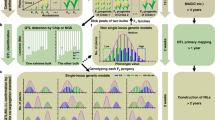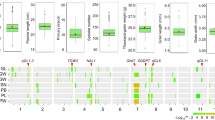Abstract
Grain yield is controlled by quantitative trait loci (QTLs) derived from natural variations in many crop plants. Here we report the molecular characterization of a major rice grain yield QTL that acts through the determination of panicle architecture. The dominant allele at the DEP1 locus is a gain-of-function mutation causing truncation of a phosphatidylethanolamine-binding protein-like domain protein. The effect of this allele is to enhance meristematic activity, resulting in a reduced length of the inflorescence internode, an increased number of grains per panicle and a consequent increase in grain yield. This allele is common to many Chinese high-yielding rice varieties and likely represents a relatively recent introduction into the cultivated rice gene pool. We also show that a functionally equivalent allele is present in the temperate cereals and seems to have arisen before the divergence of the wheat and barley lineages.
This is a preview of subscription content, access via your institution
Access options
Subscribe to this journal
Receive 12 print issues and online access
$209.00 per year
only $17.42 per issue
Buy this article
- Purchase on Springer Link
- Instant access to full article PDF
Prices may be subject to local taxes which are calculated during checkout




Similar content being viewed by others
References
Yuan, L. Hybrid rice breeding for super high yield. Hybrid Rice 12, 1–6 (1997).
Khush, G.S. Green revolution: preparing for the 21st century. Genome 42, 646–655 (1999).
Zhang, Q. Strategies for developing green super rice. Proc. Natl. Acad. Sci. USA 104, 16402–16409 (2007).
Yang, S. et al. The primary discussion on the theories and methods of the ideotype breeding of rice. Acta Agron. Sin. 17, 6–13 (1984).
Xu, Z., Zhang, W., Zhang, L. & Yang, S. Creation of new plant type and breeding rice for super high yield. Acta Agron. Sin 27, 665–672 (2001).
Sakamoto, T. & Matsuoka, M. Identifying and exploiting grain yield genes in rice. Curr. Opin. Plant Biol. 11, 209–214 (2008).
Li, X. et al. Control of tillering in rice. Nature 422, 618–621 (2003).
Ashikari, M. et al. Cytokinin oxidase regulates rice grain production. Science 309, 741–745 (2005).
Fan, C. et al. GS3, a major QTL for grain length and weight and minor QTL for grain width and thickness in rice, encodes a putative transmembrane protein. Theor. Appl. Genet. 112, 1164–1171 (2006).
Song, X. et al. A QTL for rice grain width and weight encodes a previously unknown RING-type E3 ubiquitin ligase. Nat. Genet. 39, 623–630 (2007).
Xue, W. et al. Natural variation in Ghd7 is an important regulator of heading date and yield potential in rice. Nat. Genet. 40, 761–767 (2008).
Shomura, A. et al. Deletion in a gene associated with grain size increased yields during rice domestication. Nat. Genet. 40, 1023–1028 (2008).
Xu, Z. et al. The heredity of the erect character and relation with other characters in rice. J. Shenyang Agric. Univ. 26, 1–7 (1995).
Kong, F. et al. Molecular tagging and mapping of the erect panicle gene in rice. Mol. Breed. 19, 297–304 (2007).
Yan, C. et al. Identification and characterization of a major QTL responsible for erect panicle trait in japonica rice (Oryza sativa L.). Theor. Appl. Genet. 115, 1093–1100 (2007).
Rao, N.N., Prasad, K., Kumar, P.R. & Vijayraghavan, U. Distinct regulatory role for RFL, the rice LFY homolog, in determining flowering time and plant architecture. Proc. Natl. Acad. Sci. USA 105, 3646–3651 (2008).
Kellogg, E.A. Floral displays: genetic control of grass inflorescences. Curr. Opin. Plant Biol. 10, 26–31 (2007).
Kurakawa, T. et al. Direct control of shoot meristem activity by a cytokinin activating enzyme. Nature 445, 652–655 (2007).
Komastu, K. et al. LAX and SPA: major regulators of shoot branching in rice. Proc. Natl. Acad. Sci. USA 100, 11765–11770 (2003).
Komastu, M. et al. FRIZZY PANICLE is required to prevent the formation of axillary meristems and to establish floral meristem identity in rice spikelets. Development 130, 3841–3850 (2003).
Nakagawa, M., Shimamoto, K. & Kyozuka, J. Overexpression of RCN1 and RCN2, rice TERMINAL FLOWER 1/CENTRORADIALIS homologs, confers delay of phase transition and altered panicle morphology in rice. Plant J. 19, 743–750 (2002).
Hiei, Y., Ohta, S., Komari, T. & Kumashiro, T. Efficient transformation of rice (Oryza sativa L.) mediated by Agrobacterium and sequence analysis of the boundaries of the T-DNA. Plant J. 6, 271–282 (1994).
Zhao, T. et al. Transgenic wheat progeny resistant to powdery mildew generated by Agrobacterium inoculum to the basal portion of wheat seedling. Plant Cell Rep. 25, 1199–1204 (2006).
Fu, X. et al. Expression of Arabidopsis GAI in transgenic rice represses multiple gibberellin responses. Plant Cell 13, 1791–1802 (2001).
Jiang, C. et al. Root architecture and anthocyanin accumulation of phosphate starvation responses are modulated by the GA-DELLA signaling pathway in Arabidopsis. Plant Physiol. 145, 1460–1470 (2007).
Acknowledgements
We thank N. Harberd and Y. Xue for their critical comments. This research was supported by grants from the Ministry of Science and Technology of China (2009CB941501, 2007AA10Z190 and 2006AA10A101), Chinese Academy of Sciences (KSCX2-YW-N-050) and National Natural Science Foundation of China.
Author information
Authors and Affiliations
Contributions
X.H. performed most of the experiments; Q.Q. conducted the QTL analysis and developed the NILs; Z.L and H.S. helped X.H. with analysis of field experiments; S.H. characterised transgenic wheat plants; D.L. conducted in situ hybridization experiments; G.X. performed wheat transformation and C.C. rice transformation; J.L. and X.F. supervised the study; X.F. designed the experiments and wrote the manuscript. All the authors discussed the results and contributed to the manuscript.
Corresponding author
Supplementary information
Supplementary Text and Figures
Supplementary Methods, Supplementary Tables 1–5 and Supplementary Figures 1–8 (PDF 800 kb)
Rights and permissions
About this article
Cite this article
Huang, X., Qian, Q., Liu, Z. et al. Natural variation at the DEP1 locus enhances grain yield in rice. Nat Genet 41, 494–497 (2009). https://doi.org/10.1038/ng.352
Received:
Accepted:
Published:
Issue Date:
DOI: https://doi.org/10.1038/ng.352
This article is cited by
-
Identification of qGL4.1 and qGL4.2, two closely linked QTL controlling grain length in rice
Molecular Breeding (2024)
-
Breeding rice for yield improvement through CRISPR/Cas9 genome editing method: current technologies and examples
Physiology and Molecular Biology of Plants (2024)
-
Crop bioengineering via gene editing: reshaping the future of agriculture
Plant Cell Reports (2024)
-
Development of introgression lines and mapping of qGW2, a novel QTL that confers grain width, in rice (Oryza sativa L.)
Molecular Breeding (2024)
-
Fine mapping of the panicle length QTL qPL5 in rice
Molecular Breeding (2024)



